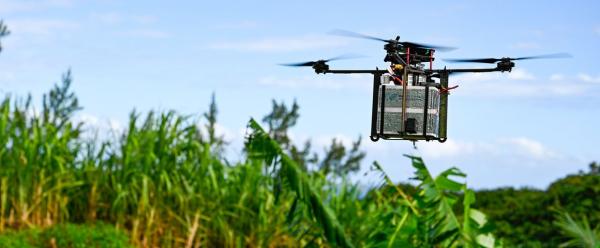Results & impact 10 October 2025
- Home
- Press area
- Press releases
- Edge effect: degradation of tropical forests
The snowball effect of humid tropical forest degradation

Secondary forest on slopes adjacent to vegetation along watercourses and agricultural areas with bare ground (Brazil). © C. Bourgoin, CIRAD
The fragmentation of tropical forests due to the expansion of agriculture or roads reduces canopy height and biomass by 20 to 30% at forest edges. This is known as the edge effect, which has been largely underestimated until now. This is one of the findings of a new study published in Nature, to which scientists from CIRAD contributed. This effect extends even further into the forest, particularly through microclimatic changes: canopy height and biomass can be affected up to 1500 metres inside the intact forest. This global edge effect calculated in the study potentially threatens up to 18% of tropical rainforests.
“The study also confirms that disturbances, such as unsustainable logging, can reduce canopy height by around 20% over a period of 20 to 30 years, and that fires cause far more significant damage, with a reduction in canopy height ranging from 40 to 60%”, says Lilian Blanc, a forest ecologist at CIRAD and co-author of the study.
“Changes in forest structure linked to cumulative human disturbances, for example due to unsustainable logging, fires and edge effects, are particularly significant”, says Clément Bourgoin from the Joint Research Centre, a former doctoral student at CIRAD and lead author of the study. “These cumulative events increase the probability of complete deforestation when 50% of canopy height is lost”.
Furthermore, degraded forests are more vulnerable to other natural disturbances, such as climate extremes, which reduce their potential resilience and threaten their long-term future.
Finally, “the time it takes for a forest to recover after deforestation is extremely long. Thirty years after deforestation, a forest will have recovered less than 60% of the height and biomass of intact forests”, says Ghislain Vieilledent, an ecologist at CIRAD and co-author of the study. “A trend projection takes forest regeneration to well beyond 100 years. This is entirely new compared to findings in other articles that give much shorter forest cover regeneration times”.
The hidden human footprint of tropical forest degradation and its effects thus call for increased efforts to prevent degradation and to protect already degraded forests in order to meet the conservation commitments made at the recent United Nations conferences on climate change and biodiversity.
Tropical forests are essential for maintaining a high level of biodiversity and mitigating climate change. Where forest loss is concerned, the focus is often on deforestation due to agriculture, mining or infrastructure construction, yet there is a whole gradient of forest conditions, ranging from intact forests to remaining but degraded forests, which are typically located on the edge of and within fragmented landscapes. These remaining forests are often degraded by unsustainable logging as well as by edge effects. In the latter case, trees on the edge of forests are exposed to adverse environmental conditions, which largely depend on their surroundings, such as roads and developed land. Forest degradation can often impact a larger area than complete deforestation and is responsible for substantial carbon emissions and biodiversity loss. However, despite its significant impact, tropical forest degradation is often ignored and neglected in public policy.
Bourgoin, C., Ceccherini, G., Girardello, M. et al. Human degradation of tropical moist forests is greater than previously estimated. Nature (2024). https://doi.org/10.1038/s41586-024-07629-0



























